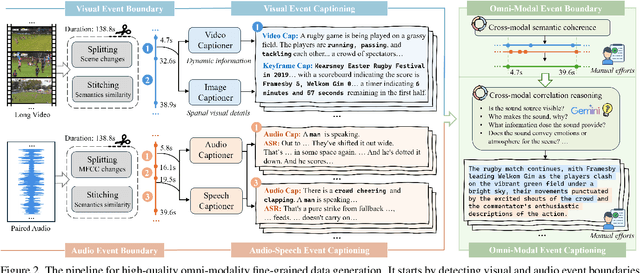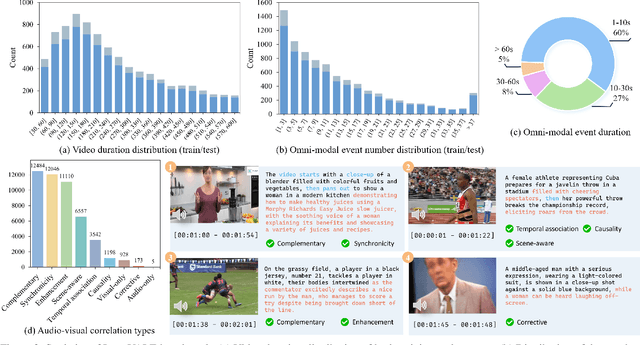Qingni Wang
LongVALE: Vision-Audio-Language-Event Benchmark Towards Time-Aware Omni-Modal Perception of Long Videos
Nov 29, 2024



Abstract:Despite impressive advancements in video understanding, most efforts remain limited to coarse-grained or visual-only video tasks. However, real-world videos encompass omni-modal information (vision, audio, and speech) with a series of events forming a cohesive storyline. The lack of multi-modal video data with fine-grained event annotations and the high cost of manual labeling are major obstacles to comprehensive omni-modality video perception. To address this gap, we propose an automatic pipeline consisting of high-quality multi-modal video filtering, semantically coherent omni-modal event boundary detection, and cross-modal correlation-aware event captioning. In this way, we present LongVALE, the first-ever Vision-Audio-Language Event understanding benchmark comprising 105K omni-modal events with precise temporal boundaries and detailed relation-aware captions within 8.4K high-quality long videos. Further, we build a baseline that leverages LongVALE to enable video large language models (LLMs) for omni-modality fine-grained temporal video understanding for the first time. Extensive experiments demonstrate the effectiveness and great potential of LongVALE in advancing comprehensive multi-modal video understanding.
Sample then Identify: A General Framework for Risk Control and Assessment in Multimodal Large Language Models
Oct 10, 2024



Abstract:Multimodal Large Language Models (MLLMs) exhibit promising advancements across various tasks, yet they still encounter significant trustworthiness issues. Prior studies apply Split Conformal Prediction (SCP) in language modeling to construct prediction sets with statistical guarantees. However, these methods typically rely on internal model logits or are restricted to multiple-choice settings, which hampers their generalizability and adaptability in dynamic, open-ended environments. In this paper, we introduce TRON, a two-step framework for risk control and assessment, applicable to any MLLM that supports sampling in both open-ended and closed-ended scenarios. TRON comprises two main components: (1) a novel conformal score to sample response sets of minimum size, and (2) a nonconformity score to identify high-quality responses based on self-consistency theory, controlling the error rates by two specific risk levels. Furthermore, we investigate semantic redundancy in prediction sets within open-ended contexts for the first time, leading to a promising evaluation metric for MLLMs based on average set size. Our comprehensive experiments across four Video Question-Answering (VideoQA) datasets utilizing eight MLLMs show that TRON achieves desired error rates bounded by two user-specified risk levels. Additionally, deduplicated prediction sets maintain adaptiveness while being more efficient and stable for risk assessment under different risk levels.
ConU: Conformal Uncertainty in Large Language Models with Correctness Coverage Guarantees
Jun 29, 2024



Abstract:Uncertainty quantification (UQ) in natural language generation (NLG) tasks remains an open challenge, exacerbated by the intricate nature of the recent large language models (LLMs). This study investigates adapting conformal prediction (CP), which can convert any heuristic measure of uncertainty into rigorous theoretical guarantees by constructing prediction sets, for black-box LLMs in open-ended NLG tasks. We propose a sampling-based uncertainty measure leveraging self-consistency and develop a conformal uncertainty criterion by integrating the uncertainty condition aligned with correctness into the design of the CP algorithm. Experimental results indicate that our uncertainty measure generally surpasses prior state-of-the-art methods. Furthermore, we calibrate the prediction sets within the model's unfixed answer distribution and achieve strict control over the correctness coverage rate across 6 LLMs on 4 free-form NLG datasets, spanning general-purpose and medical domains, while the small average set size further highlights the efficiency of our method in providing trustworthy guarantees for practical open-ended NLG applications.
 Add to Chrome
Add to Chrome Add to Firefox
Add to Firefox Add to Edge
Add to Edge